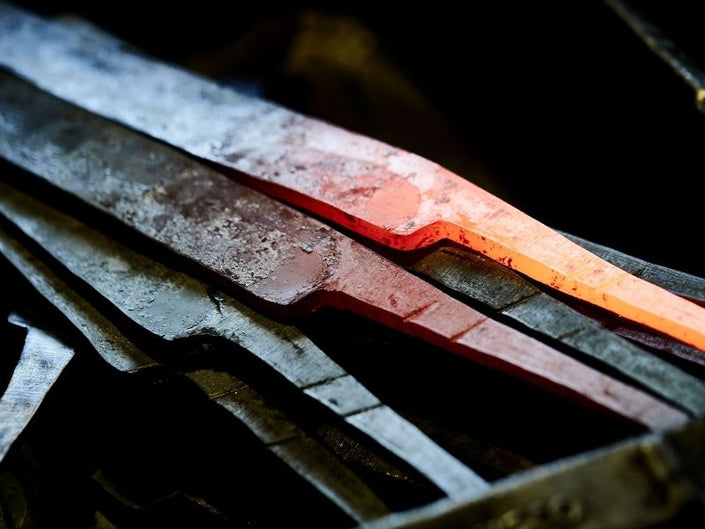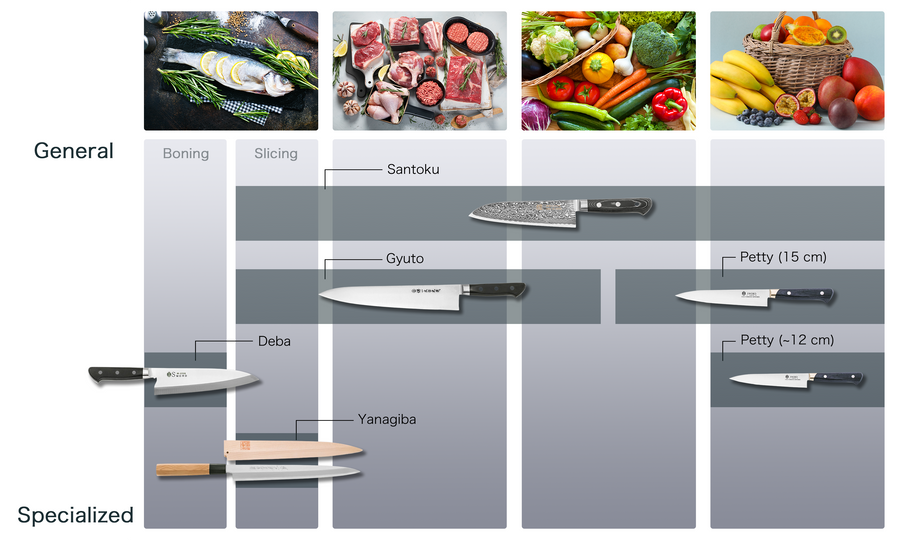
Serie Montanren
Algunos de los cuchillos forjados de mayor calidad disponibles, con niveles supremos de dureza y resistencia. Con mayor dureza y resistencia al desgaste que el Blue Steel #2, la retención del filo aumenta significativamente, lo que hace que este cuchillo sea perfecto para aquellos que cocinan durante largos periodos y necesitan un cuchillo que permanezca afilado durante toda la sesión. Un patrón ondulado llamado "Montanren" es visible en la parte posterior del cuchillo; nuestro Serie Montanren recibe su nombre de este mismo patrón. Esta onda es el límite entre el hierro más blando y el acero al carbono más duro y recuerda a los patrones que se encuentran en las espadas japonesas tradicionales.

Fugubiki
The Fugubiki is a thinner and narrow version of a classic Yanagiba, this difference in shape makes it ideal for precise cuts for thin slice such as Japanese Puffer fish. Also, it can be used to slice fish in the same way as Yanagiba.

Blue Steel #1
A harder version of Blue Steel #2. While chip-resistant with amazing edge retention, you need to know how to sharpen properly to use it.
Carbon Steel
Blue Steel #1 also contains trace amounts of tungsten and chromium for hardness and toughness, but has more carbon than Blue Steel #2. This makes Blue Steel #1 even harder, leading to better sharpness and edge retention. This steel is recommended for those who want a premium cutting experience, but also need a knife with a long lasting edge. Truly a steel for professionals.
*NOTE: Carbon Steel is susceptible to rust if it is not properly cared for. Please clean and dry the blade regularly during use and after use.

Yew octagonal handle
Handle
These handles are made from Yew wood, this wood was historically used in European Longbows due to its density, strength and rot resistance. It was also used by Prince Shotoku , a regent in the Japanese Court.This wood is characterized by its beautiful grain and a color that darkens with age.

Forge Welded
Forging Process
A forge welded blade is essentially a blade made of more than one billet of steel. There are many variations of technique and steel combinations. At its most simple, a forge welded blade is two billets of steel heated and hammer together to form one unified piece. The steel will then be shaped by hammer into the desired blade shape. Hardened and tempered, then ground, sharpened and polished. A forge welded blade has higher strength and edge retention than a stamped blade.
A knife store that has supported the history of knives and food culture in Japan.
It has been 600 years since the birth of swordmaking in the Sakai region of Japan. Sakai Ichimonji Mitsuhide's and it's craftsmen continue to build on that legacy by producing the finest blades in Japan.
This is where the culture of completing a dish of sashimi by "just cutting" and the culture of expressing sharpness as "taste" was born.
For 70 years, we have been connecting the spirit of Sakai's craftsmen with the passion of chefs in Osaka's kitchen equipment shopping district, known as the kitchen of Japan.
We are very happy that our knives can be used by people all over the world.
Precautions
After use, wash off any dirt and wipe thoroughly with a dry cloth to remove any moisture. This product is not for use with frozen foods.This product is handmade, so each piece will be different. Please use the weight and length listed as a guide. Each material is natural and may vary in color. It is not the same as the picture.We take great care with our inventory, but in the unlikely event that we are out of stock, we will contact you by email to let you know.













































